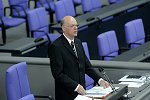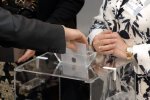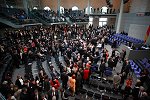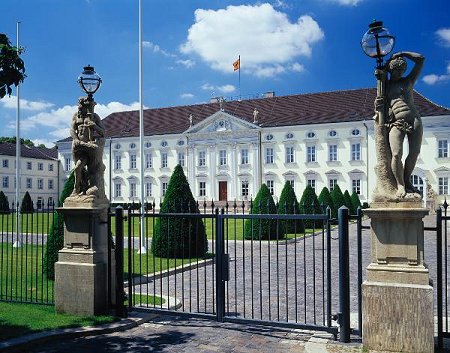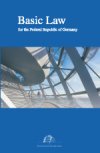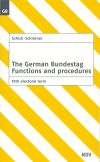Horst Köhler re-elected as Federal President
Federal President Professor Horst Köhler has been confirmed in office, winning 613 votes in the Federal Convention’s first ballot. His fellow candidate Professor Gesine Schwan won 503 votes. Peter Sodann received 91 votes. Köhler accepted his election and promised: "I will continue to give my best." His second five-year term of office will begin on 1 July.
Köhler, who was supported by the CDU/CSU and FDP, received exactly the minimum number of votes required for re-election in the first ballot. The 13th Federal Convention was composed of 1224 members, and 1223 votes were cast. One delegate, Wolfgang Gehrcke, a Member of the Bundestag from the Left Party parliamentary group, was absent due to severe illness. The Federal Convention was composed of the 612 Members of the Bundestag and an equal number of delegates nominated by the parliaments of the Länder (states).
Gesine Schwan was supported by the SPD, Peter Sodann by the Left Party. The candidate of the NPD and the DVU, Frank Rennicke, received four votes. In addition, there were ten abstentions and two invalid votes.
Function
This will be Horst Köhler's last term of office, as head of state, occupies the highest office of state in terms of protocol. As the constitutional organ which represents the Federal Republic of Germany both at home and abroad, the President makes the state - its existence, legitimacy, legality and unity - visible in all he or she does and in every public appearance. This highlights the President’s role as a force for integration and his or her monitoring function as guardian of the law and the constitution. Furthermore, the Federal President has fall-back powers in the case of a crisis of the parliamentary system of government.
Tasks
The classic functions which the Federal President as head of state performs include:
- representing the Federal Republic of Germany at home and abroad (public appearances at state, social and cultural events, speeches, visits to the Länder and communities, state visits abroad, receiving foreign state visitors),
- representing the Federal Republic of Germany for the purposes of international law (Art. 59 (1), first sentence of the Basic Law), concluding treaties with foreign states (Art. 59 (1), second sentence of the Basic Law), accrediting (appointing) German diplomatic envoys and receiving (accepting the letter of accreditation of) foreign diplomats (Art. 59 (1), third sentence of the Basic Law).
The President’s other important tasks include:
- proposing the Federal Chancellor for election (Art. 63 of the Basic Law),
- appointing and dismissing the Federal Chancellor (Art. 63 and 67 of the Basic Law) and the Federal Ministers (Art. 64 of the Basic Law),
- dissolving the Bundestag (Art. 63 (4), third sentence, Art. 68 of the Basic Law),
- promulgating (signing) and publishing laws (Art. 82 of the Basic Law),
- appointing and dismissing federal judges, federal civil servants, commissioned and non-commissioned officers (Art. 60 (1) of the Basic Law),
- exercising the power to pardon on behalf of the Federation (Art. 60 (2) of the Basic Law).
Minimum age: 40
To stand for election as Federal President, a candidate must be nominated by at least one member of the Federal Convention. Furthermore, only German citizens who are at least 40 years old and are entitled to vote in Bundestag elections can become Federal President.
If Horst Köhler is re-elected, it will be his last term of office, as re-election is only permitted once. Of the nine Federal Presidents who have held office since 1949, three were re-elected and held office for a total of ten years: Professor Theodor Heuss (1949 to 1959), Heinrich Lübke (1959 to 1969) and Dr Richard von Weizsäcker (1984 to 1994).
Dr Gustav Heinemann (1969 to 1974), Walter Scheel (1974 to 1979), Professor Karl Carstens (1979 to 1984), Professor Roman Herzog (1994 to 1999) and Johannes Rau (1999 to 2004) each served a single five-year term.
Election on Constitution Day
The Federal President's term of office begins on 1 July of the year in which the Federal Convention meets. The election must be held no later than 30 days before the end of the outgoing President's term of office. For the past 30 years, the Federal Convention has been held on 23 May, the date on which, in 1949, the Basic Law (the German constitution) was promulgated by the Parliamentary Council in Bonn. For this reason, 23 May is sometimes referred to as "Constitution Day".
Who elects the Federal President? All Members of the Bundestag -
there are currently 612 - are ex officio members of the Federal
Convention. An equal number of members are nominated by the
parliaments of the Länder, or federal states. In
2009, the Federal Convention will therefore have a total of 1224
members. The number of delegates which each individual
Land can send is determined by its population.
North Rhine-Westphalia sends the most delegates (131), followed by
Bavaria with 93, Baden-Württemberg with 78 and Lower Saxony with
61. Hesse can nominate 44 members, while Saxony can send 33,
Rhineland-Palatinate 31, Berlin 24, Schleswig-Holstein 22, Brandenburg 20, Saxony-Anhalt
19, Thuringia 18, Mecklenburg-Western Pomerania 13, Hamburg 12,
Saarland 8 and Bremen 5.
Delegates nominated by Land parliaments
The representatives of the Länder are elected by the Land parliaments. Delegates need not be members of a Land Parliament: local politicians or other public figures can also be elected.
The parliaments of the Länder elect their delegates in line with the principles of proportional representation, on the basis of lists of nominees proposed by the parliamentary groups. Nominees who are elected must accept or decline within two days. Like Members of the Bundestag, they enjoy parliamentary immunity.
The Federal President is elected in a secret ballot, without prior debate. Whichever candidate wins an absolute majority of the votes is elected. If no candidate wins an absolute majority in the first or second ballot, a relative majority is sufficient in the third ballot. New candidates may also be nominated for the second and third ballots. To date, a third ballot has been needed only in 1969 and 1994.

